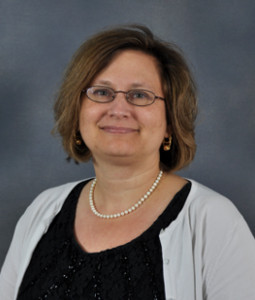Department of Chemistry and Biochemistry
Faculty and Staff Directory
Linda S. Shimizu
| Title: | Professor / Organic Biochemistry and Molecular Biology / Bioorganic / Catalysis / Crystallography / Materials / Nano / Solid State / Spectroscopy / Supramolecular |
| Department: | Chemistry and Biochemistry McCausland College of Arts and Sciences |
| Email: | shimizls@mailbox.sc.edu |
| Phone: | 803-777-2066 |
| Fax: | 803-777-9521 |
| Office: | Office: GSRC 433 Lab: GSRC 429, 803-777-7443 Lab 2: GSRC 428 |
| Resources: | CV [pdf] All Publications Linda Shimizu Group Website Department of Chemistry and Biochemistry |

Education
B.A., 1990, Wellesley College
Ph.D., 1997, Massachusetts Institute of Technology
Honors and Awards
ACS Fellow, 2025
Outstanding South Carolina Chemist, 2024
SC Governor’s Award for Scientific Awareness, 2021
Fulbright Scholar Award, 2017-2018 to Austria
Michael J. Mungo Undergraduate Teaching Award, 2016
SC ACS Volunteer of the Year, 2014
ACS Women Chemists Committee Rising Star Award, 2013
USC Breakthrough Rising Star, 2011
Research Interests
Research Areas: Organic, Supramolecular Chemistry, Nanomaterials, Bioorganic, Organic Photochemistry, and Crystal Engineering.
Organic chemists use C-C bond forming strategies to elaborate molecules generating a myriad of compounds. Nature uses non-covalent interactions to organize huge arrays of nanomaterials. We are interested in developing predictable supramolecular chemistry using non-covalent urea-urea interactions to build an array of structures and materials with a diverse array of applications.
Functional materials from bis-urea macrocycles
Nature employs self-assembly approaches to control the size and shape of biological
structures for performing specific functions. Examples include protein channels and
enzymes. A protein channel is formed by a protein that folds into a hollow tubular
structure and spans across a membrane to allow the passage of small molecules or ions
from one side of a membrane to the other side through the channel. An enzyme is a
protein that folds into a 3-dimensional structure to create a pocket of specific size
and shape for binding and converting target molecules into desired chemical products.
Inspired by Nature, our group makes small donut-shaped molecules that assemble in
high fidelity into straw-like structures called nanotubes. These nanotubes have tiny
1-dimensional channels of less than a nanometer (about 1/1000 times the width of a
strand of hair) in diameter. Our group conducts research to understand how gases
and small molecules are organized and move through these tiny channels. We also use
these nanotubes to restrict how molecules in these channels are oriented with respect
to one another, which alters how these trapped guests can react. In particular, we
are exploring photooxidations, photocycloadditions, and polymerizations within these
channels.
Exploring Methods to Control the Growth of Nanotubular Assemblies in Solution
We are interested in exploring methods to make precise nanoscale assemblies that range
from between three to 150 molecules. The goal is to create a series of ‘molecular
rulers’ between 1 to 50 nanometers in length to bridge the gap between single molecules
and supramolecular polymers. Our strategies to control the size of these nanotubular
assemblies include frustrating their growth by attaching large groups on the exterior
of the macrocycles, using chain-stopping monomers to halt the growth of the nanotubes,
and adding guests and templates that can be encapsulated within the nanotubular assemblies
to stabilize stacks of specific size. Precise control of assemblies in this size
has the potential to be transformative, opening new opportunities to understand chemical,
light-driven, and electron transfer processes that occur over these length scales.
Novel Therapeutics Targeting LY6 proteins
Dr. Upadhyay and her group at Uniformed Services are working to understand the mechanistic
role of cancer biomarkers in tumor progression and test their applicability in the
treatment of triple-negative breast cancer and pancreatic ductile carcinoma. We
are collaborating with the Upadhyay group and Dr. Maksymilian Chruszcz at Michigan
State University to develop new compounds that target Lymphocyte antigen-6 genes and
the cell surface proteins LY6K and LY6D. This LY6K protein is required for transforming
growth factor-beta and interferon-gamma signaling specific to triple-negative breast
cancer.
Chemistry Outreach Program to K-12 schools
Professor Shimizu also runs a program that brings chemists to K-12 classrooms to showcase
chemistry and the scientific method. Initiated in 2000, the program connects faculty,
post-docs, graduate students and undergraduates with K-12 students and teachers. We
visit schools to present experiments that encourage participation and highlight the
curriculum standards of 2nd (states of matter, magnets), 5th (mixtures and solutions),
7th (introductory chemistry) and high school chemistry. Each spring, we visit ~ 10
schools giving nearly forty presentations for a thousand students. If you are interested
in participating in the program please email Prof. Shimizu directly.
Selected Publications
- Wijesekera, Gamage Isuri P.; Rushton, Isabella G.; Samant, Vaibhavi A.; Gbadamosi,
Fahidat A.; Smith, Mark D.; Wetthasinghe, Shehani T.; Garashchuk, Sophya; Shimizu,
Linda S. Kinetic Control and Trapping in the Supramolecular Polymerization of m-Terphenyl
Bis-Urea Macrocycle, Chem.-Eur. J. 2025, 31, e202404552.
https://doi.org/10.1002/chem.202404552. - Wijesekera, Gamage Isuri P.; Gbadamosi, Fahidat; Hossain, Muhammad Saddam; Patra, Abhilash; Sutton, Christopher A.; Shimizu, Linda S. Understanding the Key Factors for Photoinduced Radical Generation in Crystalline Triphenylamines Using Experiment and Machine Learning. J. Phys. Chem. C. 2024, 128, 16713-16720. https://pubs.acs.org/doi/10.1021/acs.jpcc.4c03579
- Prakash, Rahul; Esmaeili, Mohsen; Gbadamosi, Fahidat; Pellechia, Perry J.; Sadati,
Sanaz; Shimizu, Linda S. Supramolecular Gelation of Triphenylamine Bis-Urea Macrocycles
in Toluene. Macromolecules 2024, 57, 1312-1318.
https://pubs.acs.org/doi/10.1021/acs.macromol.3c02402 - Rubert, Llorenc; Islam, Md. Faizul; Greytak, Andrew B.; Prakash, Rahul; Smith, Mark D.; Gomila, Rosa Maria; Frontera, Antonio; Shimizu, Linda S.; Soberats, Bartomeu. Two-Dimensional Supramolecular Polymerization of a Bis-Urea Macrocycle into a Brick-Like Hydrogen-Bonded Network. Angew. Chem. Int. Ed. 2023, 62, e202312223. https://doi.org/10.1002/anie.202312223
- Prakash, Rahul; Goodlett, Dustin W.; Varghese, Sheelu; Andrys, Justyna; Gbadamosi, Fahidat; Hernandez, Ricardo Arriaza.; Patel; Megha; Tiwari, Purushottam B.; Borowski, Tomasz; Chruszcz, Maksymilian; Shimizu, Linda S.; Upadhyay, Geeta Development of fluorophore labeled and biotinylated anticancer small molecule NSC243928. Bioorg. Med. Chem. 2023, 79, 117171. https://doi.org/10.1016/j.bmc.2023.117171